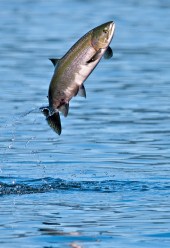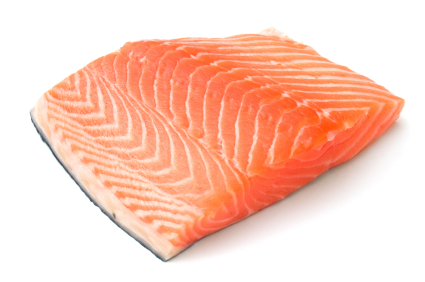The Food and Drug Administration has a special present for you this holiday season: genetically modified salmon that have been developed to grow at twice the usual salmon speed. What, you didn’t put that on your list? Well, surprise!

rogergolubRun, little salmon, the monsters are coming!
The Food and Drug Administration on Friday released its environmental assessment of the AquaAdvantage salmon, a faster-growing fish which has been subject to a contentious, yearslong debate at the agency. The document concludes that the fish “will not have any significant impacts on the quality of the human environment of the United States.” Regulators also said that the fish is unlikely to harm populations of natural salmon, a key concern for environmental activists.
The FDA will take comments from the public on its report for 60 days before making it final …
Experts view the release of the environmental report as the final step before approval.
The fish was first invented (invented!) in the ’90s but has been swimming around in regulatory limbo for the last two years, with some skeptical it would ever see a dinner plate. From Slate:
[W]ithin days of the expected public release of the [environmental assessment] this spring, the application was frozen. The delay, sources within the government say, came after meetings with the White House, which was debating the political implications of approving the GM salmon, a move likely to infuriate a portion of its base …
When asked about the holdup, FDA spokeswoman Siobhan DeLancey said, “I recommend you talk to the [Office of Management and Budget] or the White House. That’s all I’m willing to say.”
AquaBounty, the company that developed and essentially owns the monster salmon, says there’s little to no risk of fish escaping their growth pens and mating with wild salmon. Food Consumer did its own math:
Ninety-five to 99 percent of AAS [AquAdvantage salmon] are sterile, said AquaBounty at FDA hearings in 2010, so they are unlikely to breed and threaten wild salmon stocks if they escape. (If they did breed, though, it could be Jurassic Park-like since AAS eat five times more food than wild salmon and have less fear of predators, according to background materials.) Nor is 1 to 5 percent a small amount considering the 15 million eggs AquaBounty plans to grow: that could amount to 750,000 fertile fish.
Besides their massive food consumption and lack of fear (!), the FDA’s report found that the AquAdvantage salmon had a high level of infection and “jaw erosion.” There’s also a disturbingly detailed protocol for how to dispose of a whole lot of dead fish in deep “burial pits” that would be covered with plastic. Hungry yet?
With frankenfish now set to be mingling with wild and farmed varieties at the market, the next question is: How will we know? Not that they’d be required to label the stuff, but I hope AquaBounty is so pleased with its frankenfish market dominance that it’ll plaster its name all over these monster salmon meats …




